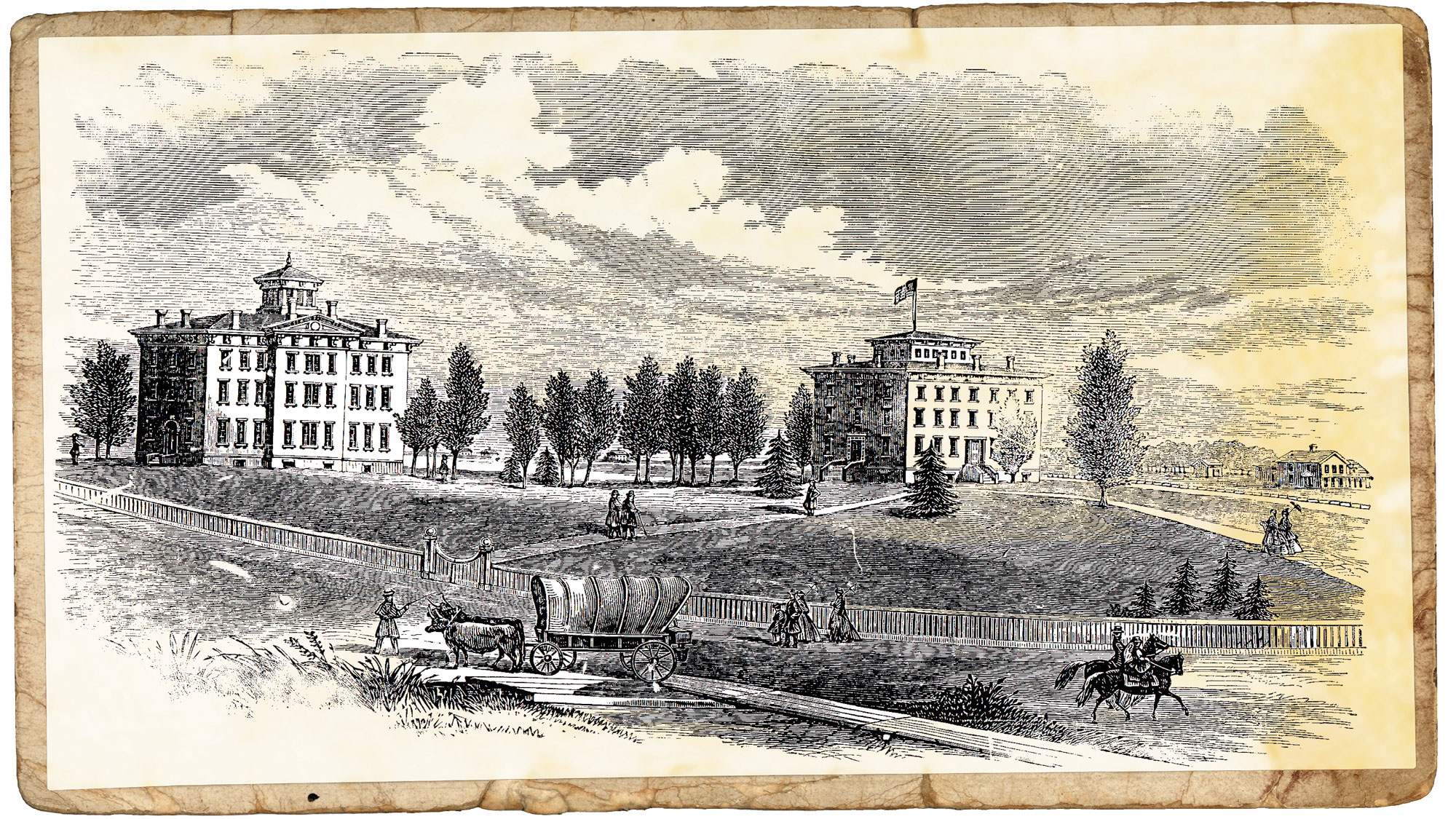Grinnell College: 1846 TO 2021 - 175th Anniversary Quiz
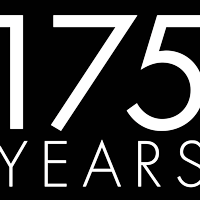 What’s the right gift for a 175th anniversary? Grinnellians know the correct answer is TRIVIA!
What’s the right gift for a 175th anniversary? Grinnellians know the correct answer is TRIVIA!
Let’s see how well you know your alma mater beyond the years you spent on campus: Take our 24-question quiz, and don't forget the bonus question. Note that some questions have more than one correct answer.
Send your bonus answers to The Grinnell Magazine with “Quiz” in the subject line for a chance to win a Grinnell prize package.
- What was the College’s original name?
- Grinnell University
- Mears College
- Iowa College
- Goodnow College
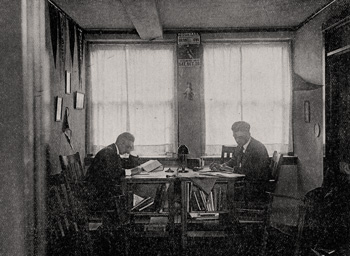
Students studying in a dormitory in 1919
- Which College president was responsible for the construction of North and South Campus residence halls, with the intention of making Grinnell “the best men’s college for men and the best women’s college for women in the country”?
- George Gates
- John Nollen
- George Magoun
- John H. T. Main
- In what eastern Iowa town did the College get its start after James J. Hill ceremoniously laid a silver dollar before those assembled and sounded a call to action to “take care of that dollar” for the new College?
- Dubuque
- Davenport
- Bettendorf
- Iowa City
- In the College’s first few decades, which of the following did it not initiate?
- A school of art
- A preparatory academy
- A conservatory of music
- A ladies’ course
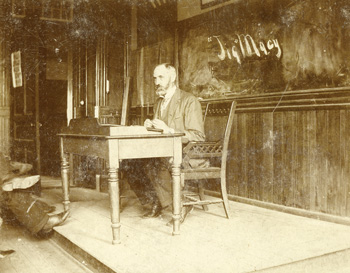
Jesse Macy achieved national prominence
- As a professor at Grinnell, Jesse Macy, class of 1870, helped develop this field of study and introduced some of the first courses in the country:
- Applied Christianity
- Social gospel
- Political science
- Sociology
- Grinnell student-athletes have participated, while students, in the following Olympics:
- 1924
- 1968
- 1992
- 2016
- In the 19th century, the College dominated these three sports:
- Baseball
- Basketball
- Football
- Track
- Before Title IX and the development of women’s intercollegiate sports teams, a handful of female athletes participated on Grinnell men’s teams, including one woman in 1963 who competed against men in the Midwest Conference in …
- Golf
- Tennis
- Cross country
- Baseball
- Beginning in the 1960s, Grinnell became known for the quality of the musical acts it brought to campus with the help of the student concerts committee. Which of the following performed at Grinnell?
- Duke Ellington
- Jefferson Airplane
- Bruce Springsteen
- The Police
- Compelling speakers have visited campus to share their expertise on everything from agriculture to zoology. Politicians have included:
- Geraldine Ferraro, 1984 Democratic, vice presidential nominee
- Former President Ronald Reagan
- U.S. Representative Shirley Chisholm (D-N.Y.)
- Former President Dwight D. Eisenhower
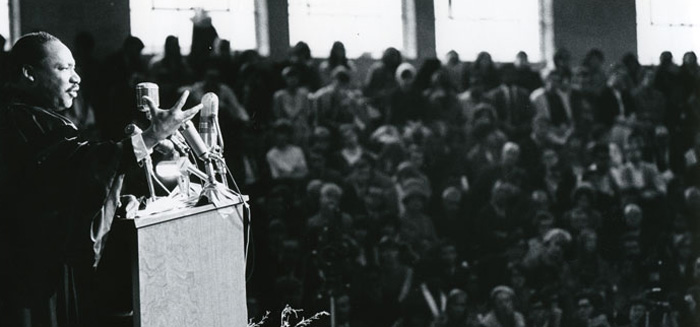
Martin Luther King Jr. in Darby Gymnasium (Photo by Robert Hodierne ’68)
- From Grinnell’s earliest days, social reform has been part of the mindset. Many successful reformers have come to campus to spark excitement about service, including:
- Harriet Beecher Stowe
- Martin Luther King Jr.
- Jane Addams
- Malala Yousafzai
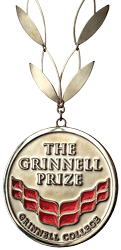
- President Raynard S. Kington, who served from 2010 to 2020, tapped into Grinnellians’ desire to serve by establishing the Grinnell College Innovator for Social Justice Prize. The prize has been awarded to organizations that:
- Champion African children’s literature
- Respond to natural disasters
- Advocate for human rights
- Create sustainable agricultural technology
- Grinnell’s first, homegrown study-abroad program, in which two Grinnell faculty taught Grinnell students, was in:
- London
- Paris
- Rome
- Cairo
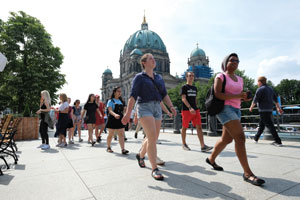
Students in Berlin (Photo by Misha Gelnarova ’18)
- Grinnell students have many options for global learning, including this most recent option, developed by the Institute for Global Engagement:
- Course-embedded travel
- The Global Learning Program
- Alternative Language Study Option
- Grinnell-in-Washington
- Since the 1850s, Grinnell’s curriculum has changed from a set of all required classical courses to an individually advised curriculum with few requirements outside the major. Identify a currently required course:
- College Writing
- Humanities 101
- First-Year Tutorial
- Historical Studies
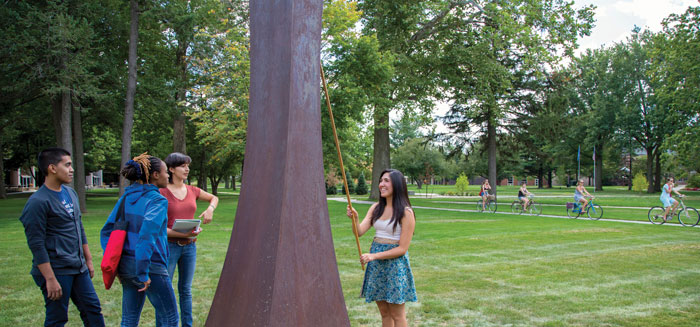
Students participate in hands-on activities during New Student Orientation in 2012
- In the early 1990s, Grinnell began rethinking how it taught certain subjects, especially to students who were underrepresented in those fields. In 2011, this ongoing program was recognized by the Obama administration:
- Grinnell Science Project
- Grinnell Math and Statistics Project
- Grinnell Humanities Project
- Grinnell Social Sciences Project
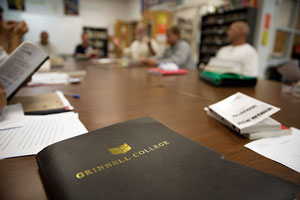
Classroom at the Newton Correctional Facility
- Initiated in 2003, Grinnell’s Liberal Arts in Prison Program currently provides to incarcerated students at the Newton Correctional Facility:
- An occasional workshop in creative writing
- An occasional course taught by student volunteers
- Regularly scheduled courses for credit, taught by Grinnell faculty
- Tutoring support from Grinnell student volunteers
- Grinnell students like to contribute to the common good, and the Center for Careers, Life, and Service (CLS) can help them find and create positions, including:
- Local volunteer opportunities
- Community-engaged courses
- Service-learning work-study positions
- Postgraduate service jobs
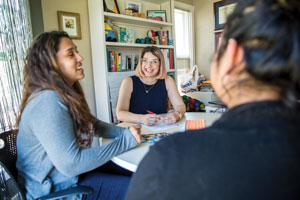
Advising students is a core part of the CLS mission
- In 2013, Mark Peltz, Daniel ’77 and Patricia Jipp ’80 Finkelman Dean of Careers, Life, and Service, implemented a novel approach at the CLS to help students prepare for meaningful careers. The program now includes this component:
- A career adviser for each incoming first-year or transfer student
- Industry-focused advising and programming through seven distinct Career Communities
- Grant funding to send students to professional conferences
- Grant funding to help students purchase interview attire
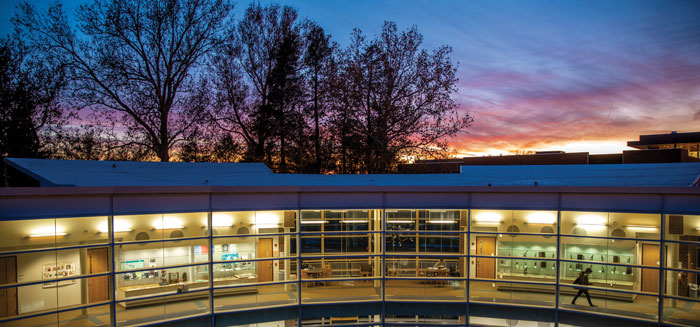
Noyce Science Center “Elbow”
- President Russell K. Osgood, who served from 1998 to 2010, presided over a significant increase in enrollment, faculty size, and new and renovated buildings, including:
- East Campus residence halls
- Joe Rosenfield ’25 Center
- Bucksbaum Center for the Arts
- Robert N. Noyce ’49 Science Center
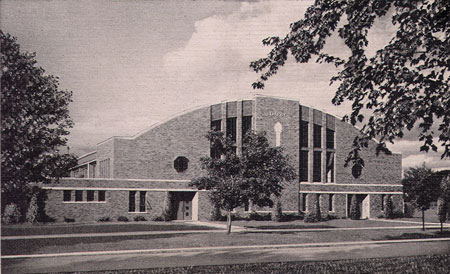
Darby Gymnasium, 1950 (Photo courtesy of the Grinnell College archives)
- Darby Gymnasium, formerly a separate building on the north side of Eighth Avenue, is now part of this building:
- Harris Center
- Physical Education Complex
- Charles Benson Bear ’39 Recreation and Athletic Center
- Rand Gymnasium
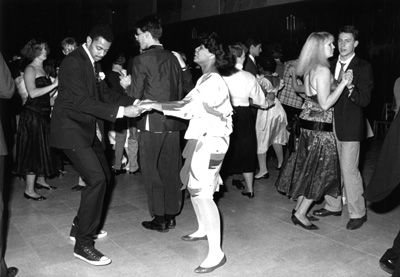
Students dancing at the Fall Waltz in 1986 (Photo courtesy of the Grinnell College archives)
- Dressing up in fancy clothes or costumes and going to a dance on campus was a tradition that began with the all-female Colonial Ball, first held in 1909. The fancy-dress dance tradition continues in the 21st century under what name?
- Mardi Gras
- Waltz
- Grinnell Ball
- Winter Wonderland
- In a Mentored Advanced Project (MAP), students work closely with a faculty member on a research or creative project that integrates the knowledge and skills they gained at Grinnell. Over the past several years, what percentage of students completed a MAP?
- 2%
- 20%
- 40%
- 100%

Conard Environmental Research Area
- A contemporary visitor to the 365-acre Conard Environmental Research Area, about 11 miles southwest of Grinnell, will find:
- Rows and rows of corn and soybeans, as far as the eye can see
- Restored native tallgrass prairie, oak savanna, woodlands, and wetlands
- An LEED-certified environmental education center with classroom, laboratory, and greenhouse
- Grinnell College’s farm
Bonus Question
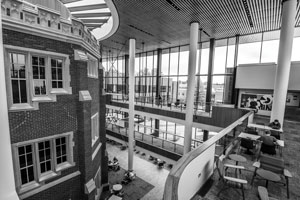
What buildings on campus, familiar to all alumni, recently were renovated and are now part of the Humanities and Social Studies Center (HSSC)?
Send your bonus answer to magazine[at]grinnell[dot]edu with “Quiz” in the subject line for a chance to win a Grinnell prize package.

How did you do on the 175th Anniversary Quiz? Check your answers below.
- C. Iowa College
- D. Main
- B. Davenport
- A. art school
- C. political science
- A., B., and D. F. Morgan Taylor 1926 took gold for the 400-meter hurdles in Paris in the 1924 games, setting a record in the process. Norris Stubbs ’72 ran the 100- and 200-meter dashes for the Bahamas in 1968 in Mexico City. Joshua Tibatemwa ’19 represented his native Uganda in the 2016 Summer Olympics in Rio de Janeiro. He swam the 50-meter freestyle.
- A., C., and D. All for men. Baseball was the first organized sport.
- A. In her first year at Grinnell, Julie Litchfield (now Tallman) ’66 shot a 94 and led her male teammates to a double dual victory over Cornell and Coe, which forfeited. She only played one match with the men’s team, as it was ruled that Grinnell had violated a conference bylaw that competition be limited to male athletes only. The terms “athletes” and “scholar-athletes” were in the bylaws, so John Pfitsch, director of athletics, and coach Larry Crawford assumed that women were eligible.
- All of them. Each played at least once.
- C. and D. Chisholm in 1980, Eisenhower in 1965.
- B. and C. King in 1967 and Addams in 1898 as Rand Series speaker and in 1924 as Commencement speaker.
- All of them.
- A. Grinnell-in-London began in fall 1974 with 17 students.
- B. The Global Learning Program, specifically for first-year students, offers an interdisciplinary course that’s team-taught by two professors who take students abroad during spring break or shortly after the spring semester.
- C. Humanities and Historical Studies were required courses until 1970.
- A. Grinnell Science Project, launched in 1993, was honored with a 2011 Presidential Award for Excellence in Science, Mathematics and Engineering Mentoring, administered by the National Science Foundation.
- C. and D. Students in the program can earn up to 60 credits from Grinnell College.
- All of them.
- All of them.
- A., B., and D. Bucksbaum was initiated by President Pamela Ferguson but completed during Osgood’s tenure.
- C. The Bear Center brings together all of Grinnell’s sports in one large complex and replaced both Darby and the physical education complex. Their facilities could no longer meet the College’s needs. Rosenfield Center, which houses the Marketplace Dining Hall and Spencer Grill and is the main campus center, was built on roughly the same site as Darby.
- B. Waltz is the current name and seems to have appeared in 1976 after more than a decade without such an event. Mardi Gras was a costume ball held from 1947 to 1962.
- C. 40%
- B. and C. CERA is a field station used for research, class field trips, and quiet enjoyment of Iowa’s natural beauty.

